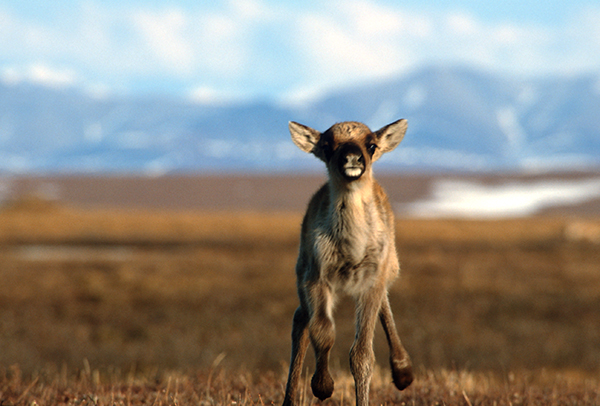UM Research Essential to Global Arctic Animal Migration Archive
MISSOULA – Warmer winters, earlier springs, shrinking ice and increased human development – the Arctic is undergoing dramatic changes impacting native animals. And now, scientists can track the movements of thousands of Arctic and sub-Arctic animals over three decades with the new global Arctic Animal Movement Archive.
Researchers from around the world, including the University of Montana, have long observed the movements and behavior of animals in the Arctic, but have had difficulty discovering and accessing data. To solve the problem, an international team led by Sarah Davidson, data curator at the Max Planck Institute of Animal Behavior in Radolfzell, Germany, and Gil Bohrer, professor at Ohio State University, established the global data archive for studies of animal migration in the Arctic and sub-Arctic. It currently contains over 200 projects and movement data of more than 8,000 marine and terrestrial animals from 1991 to the present.
The archive, hosted on the Max Planck Institute’s Movebank platform and funded by NASA, helps scientists share their knowledge and collaborate on questions on how animals are responding to a changing Arctic – particularly important because the Arctic region extends around the world. Researchers from more than 100 universities, government agencies and conservation groups across 17 countries are involved in the archive.
UM contributors include Professor Mark Hebblewhite, graduate student Stephen Lewis and former postdoctoral researcher Eliezer Gurarie. Their research is part of Hebblewhite’s funded NASA Arctic Boreal Vulnerability Experiment project that studies the effects of rapid climate change on wildlife in the Arctic, with a focus on caribou.
“UM has a long history, pioneered by researcher Steve Running, of understanding consequences of climate change to ecosystems, and this work builds on this important legacy in a region of the world undergoing some of the fastest rates of climate change, fires and impacts on people and nature,” said Hebblewhite, who studies ungulate habitat ecology.

Three recent studies from the archive reveal large-scale patterns in the behaviors of golden eagles, bears, caribou, moose and wolves in the region and illustrate how the archive can be used to recognize larger ecosystem changes. The results were published Nov. 6 in an article in Science, one of world’s premier scientific journals.
First, by comparing movements of more than 100 golden eagles from 1993 to 2017, researchers found that immature birds migrating north in the spring arrived earlier following mild winters. However, the arrival time of adults has remained rather constant, regardless of conditions at their breeding grounds, with consequences for nesting and chick survival.
The archive uses data from UM doctoral student Lewis, who is a wildlife biologist with the U.S. Fish and Wildlife Service Alaska Region, Division of Migratory Bird management. Lewis began studying the movements of golden eagles in 2012 to understand the costs of migration and carry-over effects of wintering in the contiguous U.S. for eagles born in Alaska. His data fit perfectly into the Arctic Animal Migration Archive and NASA’s Arctic Boreal Vulnerability Experiment project, and he will continue to analyze eagle movement ecology at UM.
A second study of more than 900 female caribou from 2000 to 2017 found that more northern herds are giving birth earlier in the spring, while the calving dates of more southern populations have not shown the same change.
“Caribou are the Arctic’s dominant large herbivore – an iconic symbol and crucial to Indigenous peoples for their food security and culture,” Hebblewhite said. “Yet they are declining across the Arctic, and an obvious question is the role of climate change.”
Hebblewhite said the research, which brought together an unparalleled dataset of nearly 1,000 GPS radio-collared caribou, showed a strong shift in calving dates across most of the region – and a potential contribution toward declining trends in the population.
A third analysis looking at the movement speeds of bears, caribou, moose and wolves from 1998 to 2019 showed that species respond differently to seasonal temperatures and winter snow conditions.
“Movement is central to animal survival in the harsh Arctic environment. Yet movement is costly, especially in the stark Arctic landscapes,” Hebblewhite said. “Our work showed that increasing temperatures, especially in summer, were affecting movement rates of these large mammals, which could have energetic costs that stress these species. And changes in snow in the winter were also influencing wildlife movements – also in ways that could have population impacts.”
In addition to the UM research and hundreds of studies already included in the archive, the resource is continually growing, as data are transmitted from animals in the field and more researchers join. Results should help detect changes in the behavior of animals and ultimately in the entire Arctic ecosystem.
“The Arctic is undergoing some of the most rapid climate change on the planet – upward of double the rates we are seeing here in Montana,” Hebblewhite said. “We hope our collective work shows that the changes underway in the Arctic are real and strong and affecting almost all Arctic wildlife species, as well as the ecosystems and people who depend on them.”
The Arctic Animal Movement Archive is online at https://www.movebank.org/cms/movebank-content/arctic-animal-movement-archive. The study, “Ecological insights from three decades of animal movement tracking across a changing Arctic,” is online at https://science.sciencemag.org/content/370/6517/712.
###
Note: Movement is critical for animal life in the harsh Arctic. This GIF of Arctic Animal Movement Archive data shows the key role of the Arctic globally. https://umt.box.com/s/zf926rmtc8b68b9bokre6561sm8oaf6u.
Contact: Mark Hebblewhite, professor of ungulate habitat ecology, UM W.A. Franke College of Forestry & Conservation, 406-243-6675, mark.hebblewhite@umontana.edu.